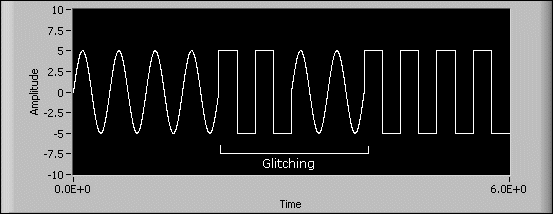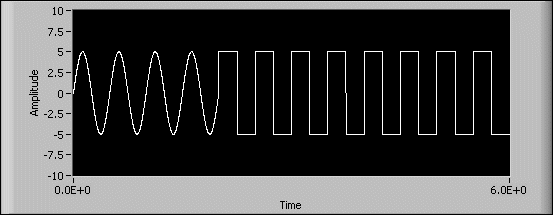Glitching
Glitching refers to the generation of a waveform in which, when transitioning from old samples in the buffer to new samples, a mixture of old and new samples is generated rather than just the new samples. This situation may occur when continuously generating samples if the Regeneration Mode write attribute/property is set to Allow Regeneration. Glitching occurs when, while you write new samples, a subset of these new samples are generated and then, since you have not finished writing all of the new samples, a subset of the old samples is generated. After your write operation completes, only the new samples are generated.
NI-DAQmx reduces the likelihood of glitching by ensuring that the writing of new samples does not overtake the generation. This glitching protection works by pausing the write until the total samples generated is more than one buffer ahead of the current write position. However, NI-DAQmx does not ensure that the generation does not overtake the new samples being written. If this occurs, a glitch results, and NI-DAQmx reports the kWarningPotentialGlitchDuringWrite warning (error 200015). The following suggestions can help you to avoid generating glitches:
- Write new samples that are almost one buffer ahead of the total samples generated. By writing the new samples almost one buffer ahead of the total samples generated, there is less of a chance that the generation overtakes the new samples that are being written. If you are updating the entire buffer at a time, wait to write the new samples until the total samples generated attribute/property is one sample greater than an integral number of buffer sizes. For example, if the buffer size is 1000 samples, wait to write new samples until the total samples generated is either 1001, 2001, 3001, and so on.
- Increase the buffer size. If the buffer size is larger, there is less of a chance that the generation overtakes the new samples that are being written.
- Decrease the sample clock rate. If the sample clock rate is slower, there is less of a chance that the generation overtakes the new samples that are being written.
In the following graphs, the sine wave is generated from old samples and the square wave is generated from the new samples. The first graph depicts glitching.

The second graph depicts the same waveforms without glitching.
